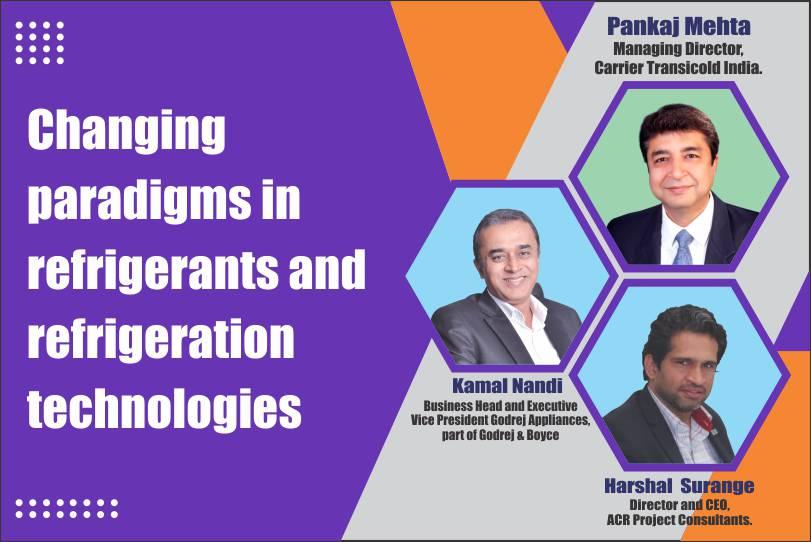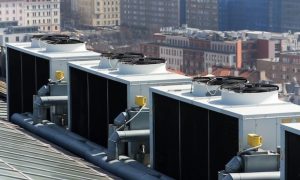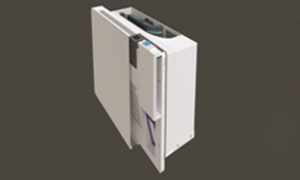Use of natural refrigerants is being reinforced extensively and technologies such as solid-state cooling and magneto-caloric are also shaping up as next gen technologies.
The use of natural refrigerants is being reinforced extensively, due to the growing concerns relating to the adverse effects on the environment. Currently, household refrigerators are using 100 percent natural refrigerant. And for categories such as domestic air conditioners and chest freezers there is scope for further adoption of natural refrigerants. The use of R290 Refrigerant – the least global warming refrigerant – in air conditioners is the plausible way as of today. According to Harshal Surange, Director and CEO, ACR Project Consultants, the overall trend has been steady. Even through the lockdown it has been fairly steady. No major jump or slump is seen, it’s been steady over the last year.
In the HVAC industry, refrigerants are used in various equipment such as air conditioners, refrigerators, freezers, etc. Refrigerants in liquid form are used in a refrigeration cycle to cool a certain space. The most widely used current applications of refrigeration are for air conditioning of private homes and public buildings, and refrigerating foodstuffs in homes, restaurants and large storage warehouses. The use of refrigerators and walk-in coolers and freezers in kitchens, factories and warehouses for storing and processing fruits and vegetables has allowed adding fresh salads to the modern diet year round, and storing fish and meats safely for long periods. The optimum temperature range for perishable food storage is 3 to 5 °C. Harshal says, ammonia refrigerant is used for most cold storage and the other category is HFCs and HFO which are basically termed as Freon, which is also prevalent in India, but over a period of time that will be phased down starting to 2028. Ammonia has another challenge that it is slightly more voluminous compared to the Freon units that have bigger inside production capacity. About five to seven years back the research was going on to develop a kind of a blend with ammonia, where the toxicity would be reduced. No Update has really come up but if something like that can happen then it will be very good. Kamal Nandi, Business Head and Executive Vice President, Godrej Appliances, part of Godrej & Boyce states, “Currently, household refrigerators are using 100 percent natural refrigerant. And for categories such as domestic air conditioners and chest freezers there is scope for further adoption of natural refrigerants.”
The refrigeration systems vary according to the purpose and the type of refrigerant used. They are the means by which we can actually carry out the refrigeration process. It is a well-known fact that the spoilage of food and many other items reduces at a lower temperature. At a lower temperature, molecular motion slows down and the growth of bacteria that causes food spoilage also retards. Thus to preserve many types of perishable food products for a longer duration, refrigerators are used in our homes, canteens, hotels, etc. The latest refrigeration technologies include magnetic refrigeration, or adiabatic demagnetisation, is a cooling technology based on the magnetocaloric effect, an intrinsic property of magnetic solids. The refrigerant is often a paramagnetic salt, such as cerium magnesium nitrate. The other one Elastocaloric refrigeration is another potential solid-state refrigeration technique and a relatively new area of study comes from a special property of super elastic materials.
Environment friendly and natural refrigerants
Environment and natural refrigerants have advantages and disadvantages, and solving these disadvantages are the technological challenges being faced by the industry. “Adoption of environmentally friendly natural refrigerants in refrigerators, and some applications have been shaping up in chest freezer for use of natural refrigeration”, says Kamal. Most refrigerants are known for having a negative effect on the environment since they contribute to global warming and ozone layer depletion. Greenhouse gases like carbon dioxide and emissions from some refrigerants are contributors to global warming by absorbing infrared radiation and holding it in the atmosphere which is called the greenhouse effect. Global Warming Potential Refrigerants have a measure of the amount of heat a gas will trap in the atmosphere over time as compared to carbon dioxide.
In order to inculcate environmental friendly usage of refrigerants, regulators are already phasing out refrigerants. Already, R22 and R142b refrigerants can not be produced or imported; restrictions on the use of R134a, R404a, and R507a refrigerants are being applied through 2024. By 2030, no HCFC refrigerants can be produced or imported into the United States. Kamal is of view that Iso-butane (R600a) and propane (R290) are some of the eco-friendly refrigerants which provide zero Ozone depletion, have extremely low global warming potential, offer excellent thermodynamic properties for higher efficiency, and provide good compatibility with component. Therefore, these are the best suggested refrigerants. Harshal states, in India we will be phasing down the Freon which is basically HFC. Baseline figure is going to be 2022 to 2024. And after that, from 2028 the phase down will run till 2040. The enforcement of new refrigerant regulations such as the EPA 680 Upgrade, and the Kigali Amendment for the phase-down of HFC refrigerants will largely impact the market growth. Freon gas is a global warming substance other than CO2 . The use of chlorofluorocarbons and hydrochlorofluorocarbons (HCFCs) as refrigerants for air conditioners in trains and buildings is currently regulated by the law concerning the protection of the ozone layer through the control of specified substances and other measures. Therefore, as alternatives, the use of hydrofluorocarbons and perfluorocarbons is increasing.
Commercial refrigeration market Leveraging energy-efficient technologies to offer low global warming potential products with rich functionalities will be the ticket to capturing significant market share in the long run. Most commercial refrigeration systems are designed to reduce temperature over a period while there are some refrigeration equipment that are specially designed to quickly reduce the temperature of food from around 900 C to as low as 300 C, in a short time. The quick change in temperature helps eliminate the threat of bacterial growth and maintain the freshness of the food items for extended periods. Sustainable and energy-efficient refrigeration systems are set to become a norm across the end-use industries, which should compel manufacturers to increase their investments in R&D and product innovations.
According to a new report published by Trends Market Research, titled, “Commercial Refrigeration Market by Product Type, and End-User: Global Opportunity Analysis and Industry Forecast, 2018-2026,” the commercial refrigeration market size was valued at $27,110 million in 2018 and is projected to reach $37,410 million by 2026, growing at a CAGR of 4.1 Percent from 2019 to 2026. The global refrigeration and air conditioning compressors market was valued at US$ 31 Bn in 2018, and is estimated to increase at a CAGR of 3 Percent during the forecast period of 2019-2029. This growth is majorly driven by the increasing consumption of refrigeration and air conditioning compressors in residential applications, commercial applications, and industrial applications. Harshal remarks, in a transportation system, you don’t really design the units because those sort of come in standard packages. We don’t really do that like you have an air conditioner. For project we actually design everything, how big should be the coil, what should be a service area, what is the airflow, what is everything all that things are designed, but in these transport refrigeration systems, they are pre designed. So, we just have to select a given range depending upon the commodity, depending on what the commodity depends on, where it is likely to be used, and what is the temperature required. Mentioning about refrigerated transportation Pankaj Mehta, Managing Director, Carrier Transicold says, an efficient post-harvest management and agri-logistics system including aggregation, pre-conditioning, pre-cooling and refrigerated transportation not only helps to reduce food loss, but also aids in expanding the reach to distant markets. A stronger, more effective cold chain is one where various stages are linked, improving how different elements work together and providing better visibility and control.
Phase change material
Government regulations are expected to play an imperative role in defining the product development and innovation strategies of market players involved in the refrigeration and air conditioning compressor market. In addition, the phase-down of R22 has compelled manufacturers to increase the adoption of R410A, R407C, and R404A, according to the FMI analyst. While commodities are in transit, Kamal says phase change materials reduce emissions and control cooling efficiency during transit. “However, we believe that the emergence of other technologies such as Peltier based solution, which is active cooling, can help consumers to retain cooling efficiency especially during transit.” According to Harshal, in refrigeration, phase change materials are mainly utilised more in the dairy sector. Where there are sudden jumps and suddenly you have all the milk coming and everything happens very quickly. So, you need a lot of refrigeration. Basically, the entire cold chain is revolving around either pharma or perishables. Change appears to be more relevant to the dairy kind of industries because the other industries have the set system. It tells us to take care of the requirements. Phase change materials are in the picture now because they are being used a lot in solar Cold storage.
Final note
Environment and natural refrigerants have advantages and disadvantages, and solving these disadvantages are the technological challenges being faced by the industry. After a period of transition and coexistence with fluorinated refrigerants with a moderate greenhouse effect, natural refrigerants will satisfy the various needs of the refrigeration and air-conditioning sector. Fluorinated refrigerants with a high greenhouse effect will be definitively abandoned in favour of alternative refrigerants and solutions. The growing demand for frozen products among consumers has increased owing to the rapid urbanisation and changing lifestyle. According to Kamal, proliferation of inverter technology in electrical drives, better insulation and sealing materials in existing refrigeration technologies will expand its applications with respect to adoption. Technologies such as Solid-state cooling and Magneto-Caloric may also shape up as next gen technologies.
Cookie Consent
We use cookies to personalize your experience. By continuing to visit this website you agree to our Terms & Conditions, Privacy Policy and Cookie Policy.















